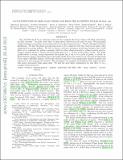NuSTAR DETECTION OF HARD X-RAY PHASE LAGS FROM THE ACCRETING PULSAR GS 0834–430
Author(s)
Miyasaka, Hiromasa; Bachetti, Matteo; Harrison, Fiona A.; Furst, Felix; Barret, Didier; Bellm, Eric C.; Boggs, Steven E.; Chakrabarty, Deepto; Chenevez, Jerome; Christensen, Finn E.; Craig, William W.; Grefenstette, Brian W.; Hailey, Charles J.; Madsen, Kristin K.; Natalucci, Lorenzo; Pottschmidt, Katja; Stern, Daniel; Tomsick, John A.; Walton, Dominic J.; Wilms, Jorn; Zhang, William; ... Show more Show less
DownloadChakrabarty_Nustar detection.pdf (508.7Kb)
OPEN_ACCESS_POLICY
Open Access Policy
Creative Commons Attribution-Noncommercial-Share Alike
Terms of use
Metadata
Show full item recordAbstract
The Nuclear Spectroscopic Telescope Array hard X-ray telescope observed the transient Be/X-ray binary GS 0834–430 during its 2012 outburst—the first active state of this system observed in the past 19 yr. We performed timing and spectral analysis and measured the X-ray spectrum between 3-79 keV with high statistical significance. We find the phase-averaged spectrum to be consistent with that observed in many other magnetized, accreting pulsars. We fail to detect cyclotron resonance scattering features that would allow us to constrain the pulsar's magnetic field in either phase-averaged or phase-resolved spectra. Timing analysis shows a clearly detected pulse period of ~12.29 s in all energy bands. The pulse profiles show a strong, energy-dependent hard phase lag of up to 0.3 cycles in phase, or about 4 s. Such dramatic energy-dependent lags in the pulse profile have never before been reported in high-mass X-ray binary pulsars. Previously reported lags have been significantly smaller in phase and restricted to low energies (E < 10 keV). We investigate the possible mechanisms that might produce this energy-dependent pulse phase shift. We find the most likely explanation for this effect is a complex beam geometry.
Date issued
2013-09Department
Massachusetts Institute of Technology. Department of Physics; MIT Kavli Institute for Astrophysics and Space ResearchJournal
The Astrophysical Journal
Publisher
IOP Publishing
Citation
Miyasaka, Hiromasa, Matteo Bachetti, Fiona A. Harrison, Felix Furst, Didier Barret, Eric C. Bellm, Steven E. Boggs, et al. “NuSTAR DETECTION OF HARD X-RAY PHASE LAGS FROM THE ACCRETING PULSAR GS 0834–430.” The Astrophysical Journal 775, no. 1 (September 20, 2013): 65.
Version: Original manuscript
ISSN
0004-637X
1538-4357